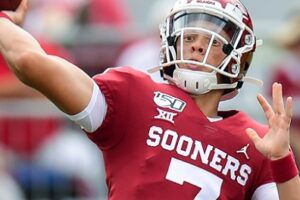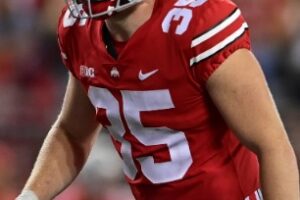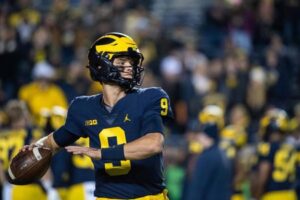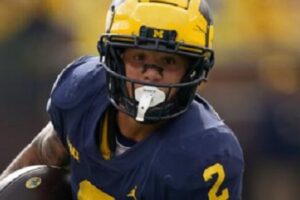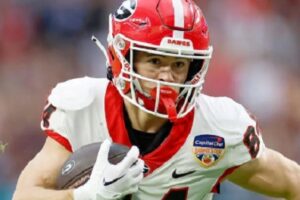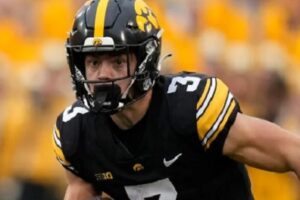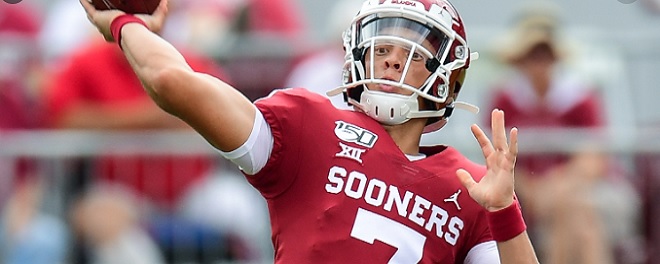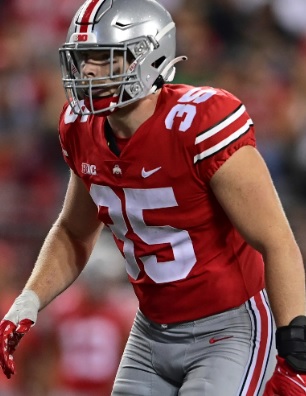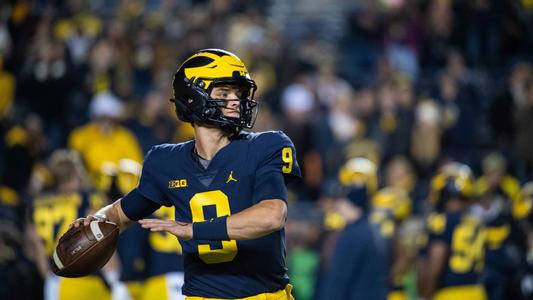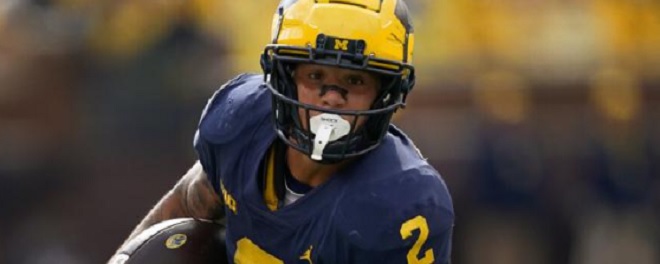By Charlie Campbell.
Send Charlie an e-mail here: [email protected]
Follow Charlie on Twitter @draftcampbell for updates.
This page was last updated April 11, 2014. Follow me @walterfootball for updates.
Position Review: Running Backs
Running Back Class
Early-round talent: B
Mid-round: B+
Late-round: B+
Overall grade: B+
2014 prospects vs 2013
Carlos Hyde = Giovani Bernard
Jeremy Hill > Le’Veon Bell
Bishop Sankey > Montee Ball
Tre Mason < Eddie Lacy
Lache Seastrunk = Christine Michael
Ka’Deem Carey > Knile Davis
Devonta Freeman = Johnathan Franklin
Andre Williams < Marcus Lattimore
This year’s draft class features a solid group of running backs, and this group is slightly better than last year’s class. The 2014 class is similar to last year in that neither one should have a player selected in the first round. That happened for the first time in 50 years in 2013 and looks likely to happen again this May. What makes the 2014 class stronger is there are more quality runners for the second day than in the 2013 NFL Draft.
If you were to mix the classes, there would be some parity at the top. Hyde, Bernard and Hill all grade out as high second-round picks. They would all go ahead of Bell. Sankey would go behind Bell but ahead of Montee Ball. Mason is at least equal to Ball if not better.
The odd part of merging these classes is Lacy. He is in the running as the best back of all and belongs in the group of Hyde, Bernard and Hill. Lacy fell to Green Bay because of injury concerns, but after one season, that looks like a poor job of evaluating by Pittsburgh and Denver.
Seastrunk and Michael are similar and are about equal as prospects. Michael should have a higher draft slot because he was in a weaker draft class. Carey is a better prospect than Davis. Freeman is about equal to Franklin, while Williams would go behind Lattimore.
The 2013 class also had a steal on the third day in Zac Stacy, and this year’s draft class features a lot of good talents on Day 3. One or more of this group could end up being the Stacy or Alfred Morris steal selection on the third day: Kapri Bibbs, Terrance West, Jerick McKinnon, Charles Sims and Lorenzo Taliaferra among others.
Safest Pick: Carlos Hyde, Ohio State

The 5-foot-11, 230-pound Hyde is a well-rounded back entering the NFL. He is a power back who is built to be workhorse and wear down defenses. With surprising quickness and receiving ability, Hyde looks like a safe pick to be a difference-maker. He also can give a team a physical, running dimension to ice away wins. Hyde will need to develop his blitz protection, but he has the skill set to be a good blocker. Early in his career, Hyde could be a three-down back and one of the better backs in the league.
Biggest Bust Potential: Lache Seastrunk, Baylor

Seastrunk was a feast-or-famine back in college, which doesn’t exactly bode well for his NFL career. Add in that he has little experience in the passing game and you get some serious bust potential. Seastrunk also got nicked up during his final season, so durability could be an issue. He has a lot of talent, but those flaws could lead to him not panning out in the NFL.
Running Back Rankings by Attributes
Natural Running Ability:
NFL prototype: Adrian Peterson, Vikings
- Carlos Hyde
- Jeremy Hill
- Bishop Sankey
- Tre Mason
- Lache Seastrunk
- Andre Williams
- Devonta Freeman
- Ka’Deem Carey
Recap: There are still a number of coaches in the NFL who want an old-school approach of a running-based offense. Plus, a lot of passing-led offenses want a back who can wear down defenses in the second half. All of these 2014 backs are good runners.
In terms of a runner to carry the load and take over games, Hyde and Hill are the top backs in the 2013 NFL Draft. They are strong backs who beat defenses with power and quickness. Both are built to take the pounding in the NFL and wear down defenses. In college, Hyde got better as games progressed. He has very good vision, balance, body lean and cutting ability. Hill has the same attributes. Many teams in the NFL are looking for runner like either of these two. WalterFootball.com knows some teams rank Hyde first, while others have Hill rated at the top.
Sankey is a different type of running back from the top two, but he is just about equal in terms of running ability. Sankey is smaller and won’t break as many tackles as the top two, thus he’s behind them.
Mason is a speedy back who is capable of ripping off long runs on any carry. He has excellent moves in the open field with good balance, body lean and vision. Seastrunk’s burst and second-gear speed make him a dangerous weapon to score on any carry. He has more strength than one would think and can run over defenders.
Williams has some power and physicality to run through tackles. Similar to Sankey, Freeman is a shifty runner with surprising strength. He ran through some tough defenses last season. Carey is a good shifty runner with vision and balance, but he may lack the size to take on a big work load in the NFL.
Pass Receiving:
NFL prototype: C.J. Spiller, Bills
- Ka’Deem Carey
- Bishop Sankey
- Devonta Freeman
- Jeremy Hill
- Carlos Hyde
- Tre Mason 12
- Lache Seastrunk
- Andre Williams
Recap: The passing-driven NFL has many offensive coordinators emphasizing running backs’ ability to help the aerial offense over actual their running ability. Coaches want backs who have good hands, run good routes and can rack up yards as outlet receivers. Carey is the best receiving back in the 2014 NFL Draft.
Carey hauled in 26 passes for 173 yards with a touchdown in 2013, but he was even better the year before with 36 receptions for 303 yards. Carey is a dangerous weapon on screen passes since he is extremely adept at getting open and is extremely difficult for linebackers or safeties to cover. Carey should be a nice weapon as a third-down back in the NFL passing game in.
Sankey is just a hair behind Carey. Sankey has good hands, runs good routes and finds a way to get open. He is already well-developed in the passing game of a West Coast offense. Sankey had 25 receptions for 298 yards and a touchdown last season.
Freeman has developed his skills as a receiver, and if he isn’t a starting running back, he could quickly become the third-down back. Freeman has good hands, runs good routes and picks up yards as a check-down target. He had 22 receptions last year and beat out other talented backs to be used in the passing game.
Hill and Hyde are good receivers for big backs. They didn’t rack up a ton of yards through the air, but at 18 and 16 receptions respectively, they showed they can function as receivers. Hyde and Hill could surprise defenses in the NFL if they neglect either of them in the passing game as both are dangerous in the open field.
Auburn didn’t throw the ball much, but Mason has some receiving ability. He looks good running routes at the Combine.
Seastrunk and Williams had zero receptions each last year. The difference between them that is Seastrunk looked good as a receiver at the Combine while Williams looked terrible. Williams is just a situational running back in the NFL.
Pass Blocking:
NFL prototype: Ahmad Bradshaw, Colts
- Devonta Freeman
- Bishop Sankey
- Ka’Deem Carey
- Carlos Hyde
- Jeremy Hill
- Lache Seastrunk
- Andre Williams
- Tre Mason
Recap: This is huge for offensive coordinators. If a running back can’t pass protect, he is going to have a hard time seeing the field in the NFL. If the defenses know that a running back isn’t trusted to protect the quarterback, it is an immediate tip about what the play is going to be. Coaches want multiple backs with pass-protection skills. The importance of blitz pickup and pass blocking is increasing every year for running backs. The college game has caught on to this, and the 2014 group of running backs is well prepared compared to past years.
Freeman was the trusted pass-blocker for the Heisman Trophy winner last year and is the best of this group. He is built well and does a nice job of reading the defense. Freeman could end up being a superb back for the passing game in the NFL.
Just a hair behind is Sankey. He is fearless taking on linebackers and was excellent protecting Keith Price. The Washington coaching staff did a great job of preparing Sankey for that role in the NFL. He is smart about which blitzers to pick up and is very good at nullifying their rushes.
Carey has potential in pass protection. There are times when he dishes out some good blocks, but he still needs some development.
Hyde and Hill both do well for bigger backs, but both will need some work for the next level. Hyde got more pass-protection reps in college than Hill did, but each one has the size to block well.
Seastrunk and Williams showed some potential as blockers last year. Each one will get better as he gains experience. Mason wasn’t required to block at Auburn. He’s basically starting from scratch in the NFL. Whichever team drafts Mason would be foolish to use him in blitz protection as a rookie.
Yards After Contact:
NFL prototype: Ray Rice, Ravens
- Carlos Hyde
- Jeremy Hill
- Andre Williams
- Devonta Freeman
- Bishop Sankey
- Tre Mason
- Lache Seastrunk
- Ka’Deem Carey
Recap: For running backs to be consistently successful in the NFL, they have to have the ability to get yards after contact. Breaking tackles is critical to moving the chains and setting up good down-and-distance situation. Hyde is the No. 1 back for this. It usually takes multiple defenders to bring him down, and he’s constantly bouncing off defenders to pick up more yards on the ground. There are times where Hyde runs angry and punishes defenders.
Hyde and Williams are very similar. They power through arm tackles with ease, and there were plenty of plays that they took defenders for a ride as they churned ahead for more yards.
While Freeman isn’t huge, he is a physical back who finishes his runs well. Freeman does a good job of fighting for extra yards and falling forward. He is compactly built and defenders can have a hard time of getting a good hold of him. Mason is similar, but he doesn’t break as many tackles as Freeman.
Seastrunk is inconsistent. There are plays when he abuses defensive backs and completely runs them over. Other times, he goes down on first contact and doesn’t seem to have much of an ability to pick up yards after getting hit. Seastrunk is a question mark, but he has potential.
Carey isn’t the biggest of backs, but he is hard for defenders to get a hold of. Carey slips out of tackles and uses a stiff arm in the open field to continue his runs. He is tougher and more physical than he is given credit for.
Zone-Blocking Runner:
NFL prototype: Arian Foster, Texans
- Carlos Hyde
- Jeremy Hill
- Tre Mason
- Andre Williams
- Lache Seastrunk
- Bishop Sankey
- Devonta Freeman
- Ka’Deem Carey
Recap: The zone-blocking scheme calls for backs to have quickness and physicality. They need the ability to follow the moving wall, use vision and anticipation to see the hole opening and make one cut to run downhill. It is a different type of running compared to a set, designed play.
Hyde showed the capacity to execute the zone-blocking scheme in 2013. He is superb as a one-cut downhill runner. Hyde could be a load as a zone runner. Hill is the same. He is a beast at running downhill has a burst to power into the second level. Both Hill and Hyde are great fits for an NFL zone scheme.
Mason has a lot the attributes to execute in zone. He can be a one-cut downhill runner who has patience and vision. The Auburn spread rushing attack has Mason prepared pretty well for a zone scheme.
Williams, Seastrunk and Sankey have enough speed and athleticism to be good fits for a zone scheme. Because they’re not as dynamic, they’re behind Hill and Hyde.
Freeman and Carey are shifty backs and aren’t so much the one-cut downhill types. Both could get by in a zone scheme, but they would be better off in a man-blocking scheme.
Power-Man Runner:
NFL prototype: Marshawn Lynch, Seahawks
- Bishop Sankey
- Tre Mason
- Devonta Freeman
- Lache Seastrunk
- Ka’Deem Carey
- Jeremy Hill
- Carlos Hyde
- Andre Williams
Recap: Washington featured Sankey as its lead runner between the tackles, and the junior did an excellent job in 2013. He should be good at executing an NFL power-man scheme almost immediately.
Mason and Freeman both ran well behind good offensive lines. Both are shifty to help their blockers and make their own holes.
When Seastrunk is running well, he looks like a very nice fit in a man scheme. Seastrunk can dodge and weave his way through traffic. Carey is similar with his good cutting ability.
Hill, Hyde and Williams are more one-cut downhill runners. They could function in a man scheme, but would be best in zone schemes.
Elusiveness:
NFL prototype: Adrian Peterson, Vikings
- Tre Mason
- Ka’Deem Carey
- Lache Seastrunk
- Devonta Freeman
- Bishop Sankey
- Andre Williams
- Jeremy Hill
- Carlos Hyde
Recap: Mason and Carey are basically tied as the most elusive runners in this draft class. They juke defenders, spin away, cut around them and use speed to run by them. Defenders really struggle to get a firm grasp on Mason or Carey.
Seastrunk is a little bit behind that group. Halfway through last season, he may have been ranked first, but he slumped after getting dinged up. That could be an issue for Seastrunk in the NFL, but he can break some ankles of defenders and embarrass them as he leaves them grasping at air.
Freeman and Sankey have elusiveness in the open field. Both can dodge tacklers. Sankey had a knack for seeming to be stopped, but slipping away for more yards. Still, Freeman and Sankey aren’t as shifty as the top three.
Williams is a strong runner who can weave through defenders in the open field. As a runner, he has a lot of balance with some moves and cutting.
Hill has some elusiveness despite being a big target. He can cut quickly to get behind defenders. While Hyde is more of a downhill runner, he uses his strength to be elusive and not let tacklers get control of him.
Breakaway Speed:
NFL prototype: Jamaal Charles, Chiefs
- Lache Seastrunk
- Tre Mason
- Jeremy Hill
- Carlos Hyde
- Ka’Deem Carey
- Devonta Freeman
- Bishop Sankey
- Andre Williams
Recap: Seastrunk is No. 1. At Baylor, he showed the ability to break off long touchdown runs in the second half of the 2012 season and the first half of 2013. There were many plays that Seastrunk produced long runs by dodging a defender in the second level and exploding down the field. He may not time the fastest, but he plays fast.
Mason has the speed to break off long runs. He consistently ripped off long runs for Auburn in 2013, including some against the better defenses he played against like Missouri.
Even though Hill and Hyde are big, powerful backs, when they break downfield, they are touch to catch. Both had some longer touchdown runs and showed the capacity for that late last season when other players were wearing down. Hill and Hyde both ran away from defenders when they broke into the open field.
Carey didn’t run well at the Combine, but he’s faster in the games. Carey had some longer touchdown runs in his career.
Freeman, Sankey and Williams all can rip off some long runs. They may not have the deep speed for the next leve. NFL safeties and cornerbacks will probably be able to chase them down.
2024 NFL Mock Draft - April 23
NFL Power Rankings - Feb. 22
Fantasy Football Rankings - Feb. 19
NFL Picks - Feb. 12

